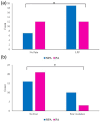Meeting exercise guidelines during pregnancy associates with less lumbopelvic disability and fear avoidance
- PMID: 40741681
- PMCID: PMC12317221
- DOI: 10.1177/17455057251321019
Meeting exercise guidelines during pregnancy associates with less lumbopelvic disability and fear avoidance
Abstract
Background: Sixty-three percent of pregnant persons report experiencing lumbopelvic pain (LPP), which can negatively impact quality of life and lead to the development of fear avoidance behaviors. Exercise is a safe, non-pharmacological treatment for reducing and preventing the development of pain, but the volume of exercise required for one to benefit from it is unknown.
Objectives: Determine whether meeting exercise guidelines during pregnancy associates with LPP, disability, and fear avoidance behaviors.
Design: Cross-sectional study.
Methods: Pregnant persons (n = 50, 32.0 ± 4.2 years, 28-32 weeks of gestation) were included. Participants completed questionnaires assessing second-trimester physical activity (PPAQ), current pain, lumbopelvic disability, and fear avoidance and then underwent a physical examination for the presence of LPP. Participants who met exercise guidelines (>150 min moderate intensity physical activity/week, PA, n = 24) were compared with those who were not physically active (<90 min moderate intensity physical activity/week, NPA, n = 26). Nonparametric tests compared groups on outcomes with significance set at p < 0.05. Post hoc odds ratios were calculated for moderate disability status. Spearman's rho correlations were conducted between physical activity (MET min/week), pain, and disability.
Results: NPA participants reported more disability due to LPP (p = 0.02), more fear avoidance behaviors (p = 0.03), and more provoked LPP (p = 0.09) than PA participants. NPA participants were also more likely to report LPP disability (OR = 3.89, 95% CI: 1.19-12.68) and fear avoidance behaviors (OR = 4.38, 95% CI: 1.03-18.56). In all participants, more moderate intensity physical activities were associated with less disability (ps < 0.05) and fewer fear avoidance behaviors (p = 0.06). Pain severity did not differ between groups (ps > 0.05).
Conclusion: Meeting pregnancy exercise guidelines throughout the second trimester associated with less LPP disability, fewer fear avoidance behaviors, and less-provoked pain, but did not associate with pain severity.
Keywords: exercise physiology; low back; peripartum; sacroiliac joints.
Plain language summary
Exercise and Pregnancy Related Lumbopelvic PainLow back and pelvic pain are common during pregnancy and impact quality of life, physical activity participation, job performance, childcare abilities, and mood. Pain can also lead to the development of avoidance behaviors, when an individual limit their activity to avoid provoking their pain. In the nonpregnant population, those who exercise more experience less back pain, reduced disability, and fewer avoidance behaviors, but more research is needed among the pregnant population. The aim of this study was to determine whether individuals who exercised regularly throughout pregnancy (greater than 150 minutes of moderate intensity exercise per week) reported less low back and pelvic pain, less disability related to back and pelvic pain, and fewer avoidance behaviors due to that pain than non-active pregnant individuals (less than 90 minutes of moderate intensity exercise per week). Participants who regularly exercised throughout pregnancy reported less low back and pelvic girdle disability and fewer avoidance behaviors than the non-active participants. The severity of back and pelvic girdle pain did not differ between groups. These findings support prior work highlighting the benefits of exercise during pregnancy. Maintaining physical activity levels that align with current recommendations (150 min/week) during pregnancy associates with less disability and avoidance behaviors. Healthcare providers should discuss the benefits of being active during pregnancy with their patients.
Conflict of interest statement
The author(s) declared no potential conflicts of interest with respect to the research, authorship, and/or publication of this article.
Figures




References
-
- Davenport MH, Marchand A-A, Mottola MF, et al. Exercise for the prevention and treatment of low back, pelvic girdle and lumbopelvic pain during pregnancy: a systematic review and meta-analysis. Br J Sports Med 2019; 53: 90–98. - PubMed
-
- Gutke A, Ostgaard HC, Oberg B. Pelvic girdle pain and lumbar pain in pregnancy: a cohort study of the consequences in terms of health and functioning. Spine (Phila, Pa 1976) 2006; 31: E149–E155. - PubMed
Publication types
MeSH terms
LinkOut - more resources
Full Text Sources
Medical
Miscellaneous

